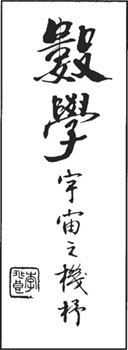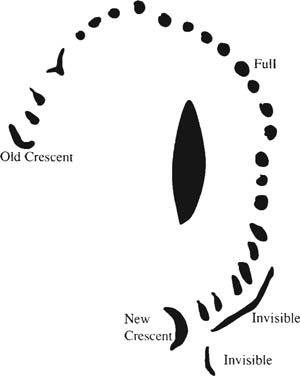
|
The future is a fabric of interlacing possibilities, some of which gradually become probabilities, and a few which become inevitabilities, but there are surprises sewn into the warp and the woof, which can tear it apart.
—Anne Rice, The Witching Hour
The Stone Age artist … relied exclusively on his mathematical instinct. It’s his instinct that has been abstracted and fettered into geometrical forms. In the course of time, it helped to develop the concept of numbers … so that finally the manifold manifestations of being in space and time could be put in order by abstract numbers.
—Annemarie Schimmel, The Mystery of Numbers, 1993 |
“Now where have you taken us?”
“Canchal de Mahoma, Spain, 7000 B.C. We’re going to see an amazing painting by an Ice Age artist.”
You walk through a maze of stalagmites and moist passages winding though one another like worm tunnels.
“Watch out!” Theano screams.
You are slipping feet first into a funnel-like pit which drops off an indeterminable distance. Theano reaches out her hand.
“No,” you cry, “I’ll take you with me.”
“No you won’t,” Theano screams. “Now grab my hand.” Her voice echoes around the cavern like the wails of ghosts.
Mr. Plex reaches his forelimb to you.
A sharp crystal rips through your shirt as you spread your legs in an attempt to stop your descent. “I’m OK,” you say holding Mr. Plex’s hand. Slowly you manage to climb your way out of the funnel.
Your body shakes. “That was close.”
Theano comes closer. “You alright?”
“I’ll survive.”
Theano nods as she takes deep breaths. “Let’s rest,” she says.
After a few minutes, your heartbeat returns to normal. The three of you seem relaxed.
Theano’s eyes wander over the cave walls. “What’s that?” she asks pointing to some marks on the wall. A vertically elongated central smudge is surrounded by spots.
Mr. Plex shuffles closer. “Sir, a war club surrounded by flies?”
You shake your head. “Actually, there was an explorer named Abbe Breuil who discovered the pattern and thought the central mark was a war club. But now most archeologists think that the club is really a symbol of God, and the spots are phases of the Moon.”
You walk closer to the wall. “Here. Take a look at this. The Moon goes through a complete period of phases in 29 or 30 days. Starting at the bottom of the figure: first there is a crescent curved on the western horizon, then a first quarter resembling half a silver dollar, then full Moon, last quarter, and crescent. There is a period of invisibility between the old and new crescent when the Moon passes in front of the sun.”
Theano studies the figure. “Pythagoras called this gap the  , the day when the old changes to the new.” She pronounces the three words as “en-i, ke, ne-a.”
, the day when the old changes to the new.” She pronounces the three words as “en-i, ke, ne-a.”

Astronomical “computer,” 7000 B.C., on a cave wall at Canchal de Mahoma, Spain.
You nod. “In the cave painting, the lunar sequence starts at the lower left with the bow of the thin crescent facing to the right, exactly as it appears in the sky at sunset. Going counterclockwise, next come six spots, one for each night of the first quarter. The eighth spot is separated, the night of the first quarter. The Moon at the top left corresponds to the end of the month with the crescent facing to the east (left) as it does in the sky.”
“Sir, this seems accurate. The crescents are pointing in the correct directions. The counterclockwise progression is the correct orbital direction of the Moon. The large gap between the old and new crescents corresponds to the days of invisibility, moonless nights.”
“Mr. Plex, what’s that on your back?” You walk over and tear off a paper stuck to Mr. Plex’s exoskeleton with some mucilagenous substance.
Mr. Plex suspiciously eyes the paper in your hand. “Sir, what in heaven’s name is it?”
You look at the page. “It seems to be from the Book of Revelation.” You pause. “Those transfinites are trying to mess with our minds again.”
Mr. Plex makes a sound like a parakeet being vacuumed out of its cage.
Theano is studying the astronomical design on the cave wall. “Pythagoras would’ve found this diagram fascinating.”
You come closer. “Why?”
“On the 17th of the month, it’s clear that the period of the full Moon is over. Pythagoras called this day ‘the barrier’ and hated this number. It was the awful night when the Moon began to die. The number 17 separates the square 16 and the oblong number 18, which are the only rectangular figures that have their areas equal to their perimeters:
16 = 4 + 4 + 4 + 4 and 16 = 4 × 4
18 = 3 + 6 + 3 + 6 and 18 = 3 × 6
Pythagoras hated 17 for other reasons, besides it being an indivisible prime number.”
“Why?”
“17 keeps the divine 16 apart from its epogdoon partner 18.”
“Epogdoon?”
“In Greek, ‘ogdoos’ means ‘eighth.’ The ‘epogdoon’ of a number is simply a number that is one-eighth greater than the original. 16 + (1/8) × 16 = 18 (its epogdoon).”
The light from the flashlight is dimming.
“Shut it off while we rest,” Theano says. “Don’t waste the battery.”
You turn off the light and look at Theano against the phosphorescent backdrop of the cave. She is surrounded by sparkling stalactites and crystals, a mineralogist’s dream. It makes Theano seem all the more alone, lost. Were you right to take her from ancient Greece?
Where is the rest of the world? It hardly matters. You hear the mystical sounds that had lulled you as a boy exploring small caverns—the humming of stalactites, the wild, desperate cry of the wind through the cave, the chilled air.
You click the light back on. Tendrils of violet helicite crystals line a nearby rock. Gypsum chandeliers sparkle like diamonds. “Not a bad place to die,” you say, running your fingers along some calcite pearls. You hand a few of the pearls to Theano. “For you, my dear.”
Theano snuggles up near a stalagmite, a Greek robe over her shoulders. Her cheeks are slightly flushed. She has never seemed more relaxed.
THE SCIENCE BEHIND THE SCIENCE FICTION
For an untouched tribe in the remote Amazon basin, a world run by terrifying humanlike gods and godlike animals provides all the story they need to survive. The myths that must sustain an industrial society in a global village … must be more useful and complex than for the rainforest tribe, no matter how much that society longs for primitive simplicity.
—Wallace Kaufman
There really is the cave Canchal de Mahoma in Spain, and it contains the astronomical diagram pictured in this chapter. The painting was made no later than 7000 B.C.—the end product of art practiced through the Ice Age. Of course, interpretation of the markings is highly speculative.
Pythagoras did call the 17th day of the month “the barrier,” and his distaste for the number 17 is well documented by Plutarch. Plutarch also wrote in Isis and Osiris that “the dismemberment of the Egyptian god Osiris into 14 parts referred allegorically to the waning days of the moon … from the time of the full moon to the new moon.”

In this chapter, we’ve discussed an ancient depiction of the Moon’s motions, which may have served as a primitive calendar. Various heavenly bodies—for example the Moon, planets, Sun, and other stars—have provided a means for measuring the passage of time since the dawn of humanity. Ancient civilizations relied upon the apparent motion of these bodies through the sky to determine seasons, months, and years. We know little about timekeeping in prehistoric eras, but wherever archeologists find records and artifacts, they also often find evidence that a culture was preoccupied with measuring and recording the passage of time. Ice Age hunters in Europe over 20,000 years ago scratched lines and chiseled holes in bones and sticks, possibly counting the days between phases of the Moon. Five thousand years ago, Sumerians in the Tigris-Euphrates valley in today’s Iraq fashioned calendars that divided the year into 30-day months, divided the day into 12 periods (each corresponding to two of our hours), and divided these periods into 30 parts (each like four of our minutes). Stonehenge architects who aligned massive columns of stone over 4000 years ago in England left no written records; however, the alignments of stones and holes suggest that Stonenenge could be used to determine seasonal or celestial events, such as lunar eclipses and solstices.
Other cultures also had early calendars. Egyptians first based their calendars on the lunar cycles, but around 4235 B.C., they used the star Sirius (the Dog Star), which rose next to the Sun every 365 days, to create a 365-day calendar. Some scholars set 4235 B.C. as the earliest recorded year in history.
Before 2000 B.C., the Babylonians (again in Iraq) had a 354-day year based on 12 alternating 29-day and 30-day lunar months. The Mayans of Central America (2000 B.C.-A.D. 1500) relied on the Sun, Moon, and Venus to establish 260-day and 365-day calendars. Their written celestial-cycle records indicated their belief that the world was created in 3113 B.C. Mayan calendars later became portions of the great Aztec calendar stones. Other civilizations, such as our own, use a 365-day solar calendar with a leap year occurring every fourth year.

 , the day when the old changes to the new.” She pronounces the three words as “en-i, ke, ne-a.”
, the day when the old changes to the new.” She pronounces the three words as “en-i, ke, ne-a.”
